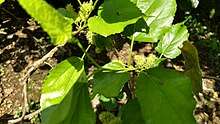Morus indica
Morus indica is a member of the genus Morus, of the family of flowering plants Moraceae, commonly known as the mulberry family. As with other mulberries, Morus indica is a deciduous tree.[1] Morus indica is native to the temperate and sub-tropical Himalayan region. It is currently cultivated in India, China, Japan, and East Africa.[2]
| Morus indica | |
|---|---|
 | |
| Morus indica with unripe berries | |
| Scientific classification | |
| Kingdom: | Plantae |
| Clade: | Tracheophytes |
| Clade: | Angiosperms |
| Clade: | Eudicots |
| Clade: | Rosids |
| Order: | Rosales |
| Family: | Moraceae |
| Genus: | Morus |
| Species: | M. indica |
| Binomial name | |
| Morus indica | |
Morphology
Morus indica, as with other members of the mulberry family, is often described as either a small tree or a shrub, rarely exceeding 10-15 meters. When young, the branches are covered in fine, soft hairs known as; however, the plant loses these hair as they grow older. The branches are a light grey-brown color.[2]
The leaves of the M. indica plant range from 1 1/2 – 5 inches long and 1 – 3 inches wide, and are attached to the tree via petioles. The leaves themselves are usually ovate but sometimes lobed, coming to a narrow point, making them somewhere between caudate and acuminate. The leaves are retuse to slightly cordate, having a small lobe at the base. The leaves are shortly serrated, with each tooth narrowing to a thin point, making them apiculate. The leaves are dark green, with a paler underside covered in fine hairs.[2]
Flowers and fruit

Morus indica is a monoecious flowering plant, having male and female flowers growing on the same tree, although often on distinct branches. The male inflorescence is narrow, between 9 – 11.5 mm long, and covered in fine hairs. The female flowers are subglubose, or just shy of spherical. They measure 6 – 9.5 mm long. The stigma of these flowers is about 3.5 mm long with dense, short hair.
The female flower, after being fertilized, forms a fleshy compound fruit known as a syncarp. This syncarp, which is black when fully ripe, looks like that of Morus nigra, commonly known as a black mulberry.[2]
Uses and health effects
Morus indica is often grown for its medicinal properties. As with most berries, the mulberries of M. indica have potent antioxidant properties.[3] The primary medicinal use of Morus indica is as a method of regulating blood glucose levels in diabetic patients. Multiple studies in humans and mice have found that the use of Morus indica lowered the blood glucose levels of diabetics through multiple different pathways.[3][4][5]
References
- Suttie JM. "Morus alba L." Food and Agriculture Organization. Archived from the original on 24 October 2012. Retrieved 20 October 2012.
- "Morus indica in Global Plants on JSTOR". plants.jstor.org. Retrieved 2 April 2019.
- Andallu, Bondada; Varadacharyulu, N. Ch (2003). "Antioxidant role of mulberry (Morus indica L. cv. Anantha) leaves in streptozotocin-diabetic rats". Clinica Chimica Acta; International Journal of Clinical Chemistry. 338 (1–2): 3–10. doi:10.1016/S0009-8981(03)00322-X. ISSN 0009-8981. PMID 14637259.
- Andallu, B.; Suryakantham, V.; Lakshmi Srikanthi, B.; Reddy, G. K. (2001). "Effect of mulberry (Morus indica L.) therapy on plasma and erythrocyte membrane lipids in patients with type 2 diabetes". Clinica Chimica Acta; International Journal of Clinical Chemistry. 314 (1–2): 47–53. doi:10.1016/S0009-8981(01)00632-5. ISSN 0009-8981. PMID 11718678.
- "Effects of Flavonoids in Morus indica on Blood Lipids and Glucose in Hyperlipidemia-diabetic Rats". Chinese Herbal Medicines. 4 (4): 314–318. November 2012. doi:10.3969/j.issn.1674-6348.2012.04.008 (inactive 2020-03-24). Retrieved 5 April 2019.